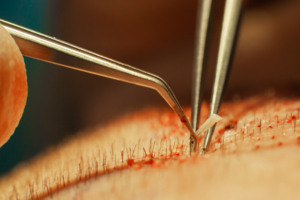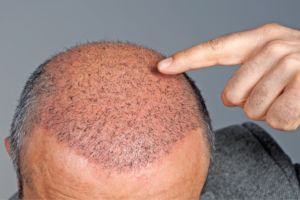Hair transplants aren’t a new thing anymore. In fact, what’s probably more ‘news’ about them is the fact that people now talk about them without shame or guilt or in quiet whispers anymore. That’s the good news. And while we’re glad that hair transplants are no longer a taboo subject, the downside of the coin (so to speak) is that now, anybody can talk about them.
At the Toronto Hair Transplant Surgeons we’re very aware that our clients need help sorting through what’s real and what’s not when they read something published in mainstream media about hair transplants. How do you know what is the truth (scientific/proven) vs what’s just marketing?
Let’s see if we can help break it down for you! We’ve taken an article published in GQ in January 2021 and asked our very own Dr Huber to comment on it for us. (You can read the article here or keep reading below for Dr Huber’s take on it – up to you!)
What did GQ get right?
Hair transplants these days look natural.
Plugs are a thing of the past. Modern hair transplants involve transplanting permanent single follicular units from one area of your head to another. That’s the science. An experienced hair transplant surgeon uses those single follicular units to recreate a natural head of hair, just like your own hair would have grown. That’s the art.
The technology is better
Advances in technology have made FUE surgery – whereby each follicular unit is excised individually – much more accessible. Large FUE surgeries, up to 3,000 follicular units or more, are now possible for some patients. This allows the surgeon to place grafts precisely where needed, even between existing hairs.
It hardly hurts at all
A small amount of numbing, taking less than a minute to administer, is all it takes to make even a large hair transplant surgery painless. The numbing lasts for the entire duration of your procedure. At our Oakville based clinic, patients spend most of their time comfortably reclined watching large screen televisions, while our surgical team does their work.
Transplanted hairs are permanent, but you do need to protect the hair you still have
Follicles are only harvested from the part of your head that grows permanent hair. When that permanent hair is moved, it stays permanent in its new home. That being said, you’ll be better off if you manage to also keep the hair you still have on your head, and maybe even grow a little bit of it back. This is where non-surgical therapies, such as finasteride, minoxidil, laser therapy, or PRP may play a role for some patients.
What did GQ get not quite right?
Technology won’t save us
The technology behind hair transplants has definitely improved in the last 30 years, resulting in transplants that look more natural. But technology isn’t everything. Experienced surgeons are still better at harvesting grafts with less damage compared to robotic harvesting machines, for example. Many inexperienced physicians are adding robotic hair transplants to their offerings, with the assumption that the robot can just do the job. But, there’s an art to hair transplants, and that’s where technology still hasn’t caught up. It’s the same reason why we still read page-turning books written by people, not machines.
- FUE is the best surgery
This article very much focused on FUE hair transplants, whereby follicles are harvested one at a time, without leaving behind a long, linear scar at the back of the head. Here at the Toronto Hair Transplant Surgeons, most of our hair transplants are FUE transplants, too. But that doesn’t mean that strip harvesting transplants, otherwise known as Follicular Unit Transplants (FUT) are bad. In fact, there’s no such thing as the “best” surgery, only the surgery that’s best for each individual patient.
The reality is, for some patients, FUE surgery isn’t a good option, but FUT surgery is. Typically, that’s true for people with very advanced hair loss, and more limited donor areas. While it’s true that FUT surgery might leave a scar at the back of your head, it can do a better job of harvesting more grafts from a smaller area, giving people with advanced hair loss a chance at more hair. And if you never plan on cutting your hair very short, it may be that no one will ever see that scar. They will, however, see all that new hair on top of your head.
It’s important that your hair transplant surgeon be experienced in both types of hair transplant surgery, so they can confidently advise you about what surgery is right for you, rather than pushing you to make a decision based on their own limited skills. Furthermore, FUT cannot be performed robotically.
And there you have it. An expert’s review of modern media’s spin on hair transplants.
What’s the most important take-away from this?
Hair transplants actually do look good now – but you still need to do your homework. If it sounds too good to be true – dig a little. The truth is out there, but sometimes it gets a bit muddled. So make sure you look for and find a reputable, skilled and experienced surgeon with credentials. Visit a site like the International Society of Hair Restoration Surgery or we also welcome you to use our contact form (above the footer) to ask one of our doctors a question.








